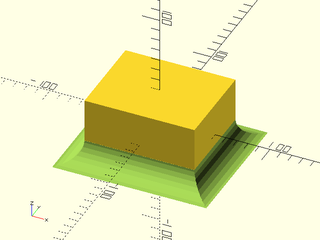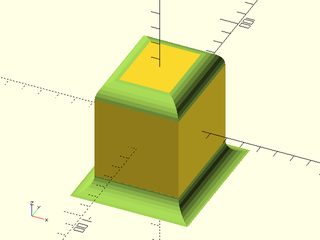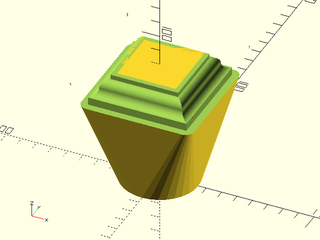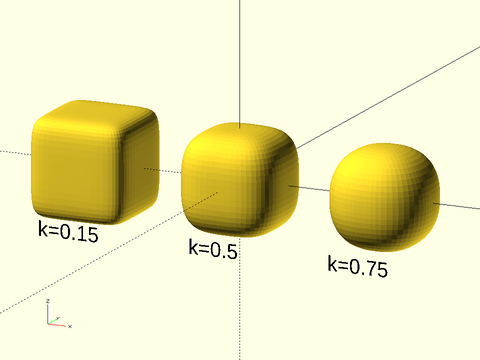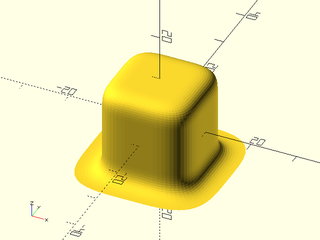Rounding the Cube
One of the shape primitives you'll use most often in your OpenSCAD designs is the cube. Rounding the edges of cube-like objects impacts both the visual appeal and functional aspects of the final design. The BOSL2 library provides a variety of methods for rounding edges and corners.
There are four different 3d shape primitives that you can use to make cube-like objects:
-
cuboid() - Creates a cube with chamfering and roundovers.
-
cube() - An extended version of OpenSCAD's cube() with anchors for attaching children. (See the Attachments Tutorial).
-
prismoid() - Creates a rectangular prismoid shape with optional roundovers and chamfering.
-
rounded_prism() - Makes a rounded 3d object by connecting two polygons with the same vertex count. Rounded_prism supports continuous curvature rounding. (See Types of Roundovers).
BOSL2 provides two different methods for rounding the edges of these cube-like primitives.
-
Built-in Rounding - The cuboid(), prismoid(), and rounded_prism() all have built-in arguments for rounding some or all of their edges.
-
Masking - BOSL2 includes a number of options for masking the edges and corners of objects. Masking can accomplish rounding tasks that are not possible with the built-in rounding arguments. For example with masking you can have a cube with a different rounding radius on the top edges than the rounding radius on the bottom edges.
Cube-like objects have six named faces: LEFT, RIGHT, TOP, BOT, FWD, BACK.
Each of those face names is a vector pointing to the face. e.g. UP is [0,0,1], and FWD is [0,-1,0]. By adding two of those vectors we can specify an edge. For example, TOP + RIGHT is the same as [0,0,1] + [0,1,0] = [0,1,1].
See Specifying Edges for more details.
Cuboid Rounding
You can round the edges of a cuboid() with the rounding argument by specifying the radius of curvature:
include <BOSL2/std.scad>
cuboid(100, rounding=20);
We can round the edges aligned with one of the axes, X, Y, or Z:
include <BOSL2/std.scad>
cuboid([100,80,60], rounding=20, edges = "Z");
You can round all the edges on one of the faces. Here we're rounding only the top edges:
include <BOSL2/std.scad>
cuboid([100,80,60], rounding=20, edges = TOP);
...or just the bottom edges. Here we're using the teardrop argument to limit the overhang angle to enable 3d printing on FDM printers without requiring supports:
include <BOSL2/std.scad>
cuboid([100,80,60], rounding=20, teardrop = 45, edges = BOTTOM);
It is possible to round one or more of the edges while leaving others unrounded:
include <BOSL2/std.scad>
cuboid([100,80,60], rounding=20, edges = TOP+FRONT);
...or exclude the rounding of one or more edges while rounding all the others:
include <BOSL2/std.scad>
cuboid([100,80,60], rounding=20, except = TOP+FRONT);
Multiple edges can be specified in the form of a list:
include <BOSL2/std.scad>
cuboid([100,80,60], rounding=20, edges=[FWD,TOP], except=[TOP+LEFT,FWD+RIGHT]);
You can also specify which edges to round using a 3x4 array, where each entry corresponds to one of the 12 edges and is set to 1 if that edge is included and 0 if the edge is not. The edge ordering is:
[
[Y-Z-, Y+Z-, Y-Z+, Y+Z+],
[X-Z-, X+Z-, X-Z+, X+Z+],
[X-Y-, X+Y-, X-Y+, X+Y+]
]
include <BOSL2/std.scad>
cuboid([100,80,60], rounding=20, edges = [[1,0,1,0],[0,1,0,1],[1,0,0,1]]);
Similarly, you can use an array to exclude selected edges from rounding:
include <BOSL2/std.scad>
cuboid([100,80,60], rounding=20, except = [[1,0,1,0],[0,1,0,1],[1,0,0,1]]);
Negative Rounding
You can fillet top or bottom edges by using negative rounding values. Note that you cannot use negative rounding values on Z-aligned (side) edges. If you need to add a fillet on a Z-aligned edge, use fillet():
include <BOSL2/std.scad>
cuboid([100,80,60], rounding=-20, edges = BOTTOM);
Chamfering
Chamfering the edges of the cuboid() can be done in a manner similar to rounding:
include <BOSL2/std.scad>
cuboid([100,80,60], chamfer=20);
You can specify edges as with rounding:
include <BOSL2/std.scad>
cuboid([100,80,60], chamfer=20, edges = "Z", except = FWD+RIGHT);
Prismoid Rounding
The prismoid() differs from the cuboid and cube in that you can only round or chamfer the vertical(ish) edges using the built-in parameters. For those edges, you can specify rounding and/or chamfering for top and bottom separately:
include <BOSL2/std.scad>
prismoid(size1=[35,50], size2=[20,30], h=20, rounding1 = 8, rounding2 = 1);
You can also specify rounding of the individual vertical(ish) edges on an edge by edge basis by listing the edges in counter-clockwise order starting with the BACK+RIGHT (X+Y+) edge:
include <BOSL2/std.scad>
prismoid(100, 80, rounding1=[0,50,0,50], rounding2=[40,0,40,0], h=50);
Masking Edges of the Cuboid, Cube and Prismoid
2D Edge Masking with edge_profile() and edge_profile_asym()
One limitation of using rounding arguments in cuboid() is that all the rounded edges must have the same rounding radius. Using masking we have the flexibility to apply different edge treatments to the same cube. Masking can also be used on the cube() and prismoid() shapes.
2D edge masks are attached to edges using edge_profile(). They have a default tag of "remove" to enable differencing them away from your cube using diff().
We can use a negative rounding value to fillet the bottom of a cuboid and edge_profile() to round the top. Here edge_profile() applies a 2d roundover mask to the top edges of the cuboid.
include <BOSL2/std.scad>
diff()
cuboid([50,60,70], rounding = -10, edges = BOT)
edge_profile(TOP)
mask2d_roundover(r=10);
We could also fillet the bottom of the cube using edge_profile_asym() and xflip()
include<BOSL2/std.scad>
cuboid(50)
edge_profile_asym(BOT, corner_type="round")
xflip() mask2d_roundover(10);
The flip argumet in edge_profile_asym() determines whether the fillet flares out or up. The corner_type argument is used to shape the corners of external fillets.
include<BOSL2/std.scad>
cuboid(50){
edge_profile_asym(TOP, flip = true)
xflip() mask2d_roundover(10);
edge_profile_asym(BOT, corner_type="round")
xflip() mask2d_roundover(10);
}
See mask2d_roundover() for additional mask parameters. Here we use the inset parameter to produce a bead.
include <BOSL2/std.scad>
diff()
cube([50,60,70],center=true)
edge_profile(TOP, except=[BACK,TOP+LEFT])
mask2d_roundover(h=12, inset=4);
You can use edge-profile() to round the top or bottom of a prismoid(). Because the side faces of a prismoid() are not strictly vertical, it's is necessary to increase the length of the masks using the excess parameter in edge_profile(), and to set the mask_angle to $edge_angle in mask2d_roundover().
include<BOSL2/std.scad>
diff()
prismoid(size1=[35,50], size2=[30,30], h=20, rounding1 = 8, rounding2 = 0)
edge_profile([TOP+LEFT, TOP+RIGHT], excess = 5)
mask2d_roundover(r = 15, mask_angle = $edge_angle, $fn = 64);
Instead of specifying the rounding radius, you can specify the height of edge rounding.
include<BOSL2/std.scad>
diff()
cube(30)
edge_profile([TOP+LEFT, TOP+RIGHT])
mask2d_roundover(h = 12, $fn = 64);
Rounding heights larger than an adjacent edge/2 will produce a ridge line on the top surface.
include<BOSL2/std.scad>
diff()
cube(30)
edge_profile([TOP+LEFT, TOP+RIGHT])
mask2d_roundover(h = 20, $fn = 64);
The mask2d_teardrop() mask can be used to round the bottom of a cube-like object. It limits the overhang angle to 45° or a value you specify in with the angle argument.
include<BOSL2/std.scad>
diff()
prismoid([30,20], [40,30], rounding = 2, h = 20, $fn = 64)
edge_profile(BOT, excess = 15)
mask2d_teardrop(h = 5, angle = 50, mask_angle = $edge_angle, $fn = 64);
In addition to the simple roundover mask, and the teardrop mask, there are masks for cove, chamfer, rabbet, dovetail and ogee edges.
The mask2d_ogee() only works on cube() and cuboid() shapes, or a prismoid() where size2 >= size1 in both the X and Y dimensions.
include <BOSL2/std.scad>
diff()
prismoid(size1 = [50,50],size2 = [80,80], rounding1 = 25, height = 80)
edge_profile(TOP)
mask2d_ogee([
"xstep",8, "ystep",5, // Starting shoulder.
"fillet",5, "round",5, // S-curve.
"ystep",3, "xstep",3 // Ending shoulder.
]);
Prismoids, espcecially prismoids with substantial shift, require careful selection of mask2d_roundover() arguments. Here we're setting radius = 5 and mask_angle = $edge_angle.
include<BOSL2/std.scad>
diff()
prismoid([30,20], [50,60], h=20, shift=[30,40])
edge_profile(TOP, excess=35)
mask2d_roundover(r=5, mask_angle=$edge_angle, $fn=128);
Specifying rounding height rather than rounding radius produces a different shape.
include<BOSL2/std.scad>
diff()
prismoid([30,20], [50,60], h=20, shift=[30,40])
edge_profile(TOP, excess=35)
mask2d_roundover(h=5, mask_angle=$edge_angle, $fn=128);
The quarter_round argument works well for edges with acute angles, but leaves a ledge on the edges with obtuse angles.
include<BOSL2/std.scad>
diff()
prismoid([30,20], [50,60], h=20, shift=[30,40])
edge_profile(TOP, excess=35)
mask2d_roundover(r=5, mask_angle=$edge_angle, quarter_round = true, $fn=128);
A work-around is to use quarter_round only on the edges with acute angles.
include<BOSL2/std.scad>
diff()
prismoid([30,20], [50,60], h=20, shift=[30,40])
edge_profile(TOP, excess=35)
mask2d_roundover(r=5, mask_angle=$edge_angle, quarter_round = $edge_angle<90, $fn=128);
3D Edge and Corner Masking
BOSL2 contains a number of 3d edge and corner masks in addition to the 2d edge profiles shown above.
The 3d edge masks have the advantage of being able to vary the rounding radius along the edge. 3d edge masks, such asrounding_edge_mask(), can be attached using edge_mask(). The 3D edge masks have a default tag of "remove" to enable differencing them away from your cube using diff().
include <BOSL2/std.scad>
diff()
cuboid(80)
edge_mask(TOP+FWD)
rounding_edge_mask(r1 = 40, r2 = 0, l = 80);
While you can specify the length of the mask with the l or h argument, edge_mask() sets a special variable, $parent_size, to the size of the parent object. In the case where the parent is not a perfect cube, you need to mask each edge individually:
include <BOSL2/std.scad>
diff()
cuboid([60,80,40]) {
edge_mask(TOP+FWD)
rounding_edge_mask(r = 10, l = $parent_size.x + 0.1);
edge_mask(TOP+RIGHT)
rounding_edge_mask(r = 10, l = $parent_size.y + 0.1);
edge_mask(RIGHT+FWD)
rounding_edge_mask(r = 10, l = $parent_size.z + 0.1);
}
As you can see above, using only rounding_edge_mask() to round the top of the cube leaves the corners unrounded. Use corner_mask() and rounding_corner_mask() for a smoother corner.
include <BOSL2/std.scad>
diff()
cuboid([60,80,40]) {
edge_mask(TOP+FWD)
rounding_edge_mask(r = 10, l = $parent_size.x + 0.1);
edge_mask(TOP+RIGHT)
rounding_edge_mask(r = 10, l = $parent_size.y + 0.1);
edge_mask(RIGHT+FWD)
rounding_edge_mask(r = 10, l = $parent_size.z + 0.1);
corner_mask(TOP+RIGHT+FWD)
rounding_corner_mask(r = 10);
}
As with the built-in rounding arguments, you can use edge_mask() and corner_mask() to apply teardrop roundings using teardrop_edge_mask() and teardrop_corner_mask() to limit the overhang angle for better printing on FDM printers. Note that the vertical mask on the RIGHT_FWD edge is a rounding_edge_mask().
include <BOSL2/std.scad>
diff()
cuboid([60,80,40]) {
edge_mask(BOT+FWD)
teardrop_edge_mask(r = 10, l = $parent_size.x + 0.1, angle = 40);
edge_mask(BOT+RIGHT)
teardrop_edge_mask(r = 10, l = $parent_size.y + 0.1, angle = 40);
edge_mask(RIGHT+FWD)
rounding_edge_mask(r = 10, l = $parent_size.z + 0.1);
corner_mask(BOT+RIGHT+FWD)
teardrop_corner_mask(r = 10, angle = 40);
}
Rounded Prism
You can construct cube-like objects, as well as a variety of other prisms using rounded_prism(). In this tutorial we're concentrating on rounding cubes, but rounded_prism() has capabilities that extend well beyond cube-like objects. See the rounded_prism() examples to learn more.
A feature unique to rounded_prism() is that it uses continuous curvature rounding. Rather than using constant radius arcs, continuous curvature rounding uses 4th-order Bezier curves. For complete details on how this works see Types of Roundovers.
Two parameters control the roundover, k and joint. The joint parameter is the distance from where the rounding starts to the unrounded edge. The k parameter ranges from 0 to 1 with a default of 0.5. Larger values give a more abrupt transition and smaller ones a more gradual transition.
A smooth roundover with a joint length of 18 and the value of k set to 0.75.

A smooth roundover, with the value of k set to 0.15. The transition is so gradual that it appears that the roundover is much smaller than specified. The cut length is much smaller for the same joint length.

The joint parameter is specified separately for the top, bottom and side edges; joint_top, joint_bot, and joint_sides.
If you want a very smooth roundover, set the joint parameter as large as possible and then adjust the k value down low enough to achieve a sufficiently large roundover. Joint parameters usually need to be < side/2.
include <BOSL2/std.scad>
include <BOSL2/rounding.scad>
rounded_prism(rect(20), height=20,
joint_top=9.99, joint_bot=9.99, joint_sides=9.99, k = 0.5);
Here we're using the same cube size and joint sizes, but varying the k parameter.
Alternatively, we can keep k constant at k=0.5 and vary the joint length:
You can match the cicrular roundover of cuboid() by setting the joint values to the rounding used in cuboid() and setting the k value to 0.93:
include <BOSL2/std.scad>
include <BOSL2/rounding.scad>
left(15)
rounded_prism(rect(20), height=20, joint_top=4, joint_bot=4, joint_sides=4, k = 0.93);
right(15)
cuboid(20, rounding = 4, $fn = 72);
Unlike other cube-like objects, the rounded prism smoothness is not affected by the special variable $fn, but by the splinesteps argument. Splinesteps defaults to 16.
The joint size can be set to different values for each side of the prism:
include <BOSL2/std.scad>
include <BOSL2/rounding.scad>
rounded_prism(rect(20), height=20,
joint_top=4, joint_bot=3, joint_sides=[2, 10, 5, 10], k = 0.5);
Likewise, k can be set to different values for each side of the prism:
include <BOSL2/std.scad>
include <BOSL2/rounding.scad>
rounded_prism(rect(20), height=20,
joint_top=3, joint_bot=3, joint_sides=8,
k_top=0.5, k_bot=0.1, k_sides=[0,0.7,0.3,0.7]);
You can specify a 2-vector for the joint distance to produce asymmetric rounding which is different on the two sides of the edge. This may be useful when one one edge in your polygon is much larger than another.
include <BOSL2/std.scad>
include <BOSL2/rounding.scad>
rounded_prism(rect([50.1,20.1]), height=6.1,
joint_top=[15,3], joint_bot=[15,3],
joint_sides=[[10,25],[25,10],[10,25],[25,10]],
k_sides=0.3);
For the top and bottom you can specify negative joint distances. If you give a scalar negative value then the roundover will flare outward.
include <BOSL2/std.scad>
include <BOSL2/rounding.scad>
rounded_prism(rect(20), height=20,
joint_top=5, joint_bot=-5, joint_sides=8, k=0.5);
If you give a 2-vector then if joint_top[0] is negative the shape will flare outward, but if joint_top[1] is negative the shape will flare upward. At least one value must be non-negative. The same rules apply for joint_bot. The joint_sides parameter must be entirely nonnegative.
Flaring the top upward. The bottom has an asymmetric rounding with a small flare but a large rounding up the side.
include <BOSL2/std.scad>
include <BOSL2/rounding.scad>
rounded_prism(rect(20), height=20,
joint_top=[3,-3], joint_bot=[-3,10], joint_sides=8, k=0.5);
Indices
Table of Contents
Function Index
Topics Index
Glossary
Cheat Sheet
Tutorials
List of Files:
Basic Modeling:
- constants.scad STD
- transforms.scad STD
- attachments.scad STD
- shapes2d.scad STD
- shapes3d.scad STD
- masks.scad STD
- drawing.scad STD
- distributors.scad STD
- color.scad STD
- partitions.scad STD
- miscellaneous.scad STD
Advanced Modeling:
- paths.scad STD
- regions.scad STD
- skin.scad STD
- vnf.scad STD
- beziers.scad STD
- nurbs.scad
- rounding.scad STD
- turtle3d.scad
- isosurface.scad
Math:
- math.scad STD
- linalg.scad STD
- vectors.scad STD
- coords.scad STD
- geometry.scad STD
- trigonometry.scad STD
Data Management:
- version.scad STD
- comparisons.scad STD
- lists.scad STD
- utility.scad STD
- strings.scad STD
- structs.scad STD
- fnliterals.scad
Threaded Parts:
Parts:
- ball_bearings.scad
- cubetruss.scad
- gears.scad
- hinges.scad
- joiners.scad
- linear_bearings.scad
- modular_hose.scad
- nema_steppers.scad
- polyhedra.scad
- sliders.scad
- tripod_mounts.scad
- walls.scad
- wiring.scad
- hooks.scad
Footnotes:
STD = Included in std.scad











